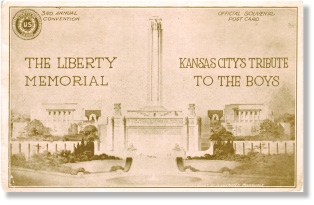
By MICHAEL BUSHNELL
Northeast News
December 5, 2012
This week’s commemorative postcard is an official souvenir card from the American Legion Convention held here in Kansas City in 1921 commemorating the site dedication of the Liberty Memorial.
Architect H. Van Buren Magonigle of New York was selected from a field of 15 architectural firms nationwide to design a memorial to the “war to end all wars.” In 1919, a huge fund drive was held to solicit public donations for the memorial. Lumber baron and Northeast resident Robert A. Long was elected founding president of the newly created organization that spearheaded the drive to construct a memorial to honor the war dead from World War I.
Upon his election to the post, Long stated: “From its inception it was intended that this memorial should represent, on the part of all people, a living expression for all time of the gratitude of a grateful nation to those who offered and who gave their lives in defense of liberty and our country.”
A little over two weeks later, a staggering $2.5 million was raised, largely through public donations, for the construction of the Liberty Memorial. On Nov. 1, 1921, during the American Legion Convention, the site for the memorial was dedicated in front of more than 200,000 people who had turned out to support the effort. Also in attendance were commanders of a number of Allied forces, including Lt. General Baron Jacques of Belgium; General Armando Vittorio Diaz of Italy; Marshal Ferdinand Foch of France; Missouri native General John J. “Blackjack” Pershing, commander of the American Expeditionary Forces; and Admiral David Earl Beatty, commander of the British Navies. Roughly five years later on Nov. 11, 1926, the finished memorial was dedicated and opened to the public.
In 1994, the memorial closed after deterioration of the concrete deck, and its reinforcing steel surrounding the tower and temples raised fears that a visitor might fall through into a 40-foot-deep void below. Plans were drawn up to create a new museum dedicated to the preservation of artifacts and documents from WWI. Those plans angered historic preservationists who argued that the new entrance of the museum destroyed the entire south lawn of the memorial. Ultimately a newly dedicated National World War I Museum opened to the public on Saturday, Dec. 2, 2006. The museum painstakingly and often graphically depicts the daily life of the “Doughboys” during their struggle for liberty “Over There.”



















